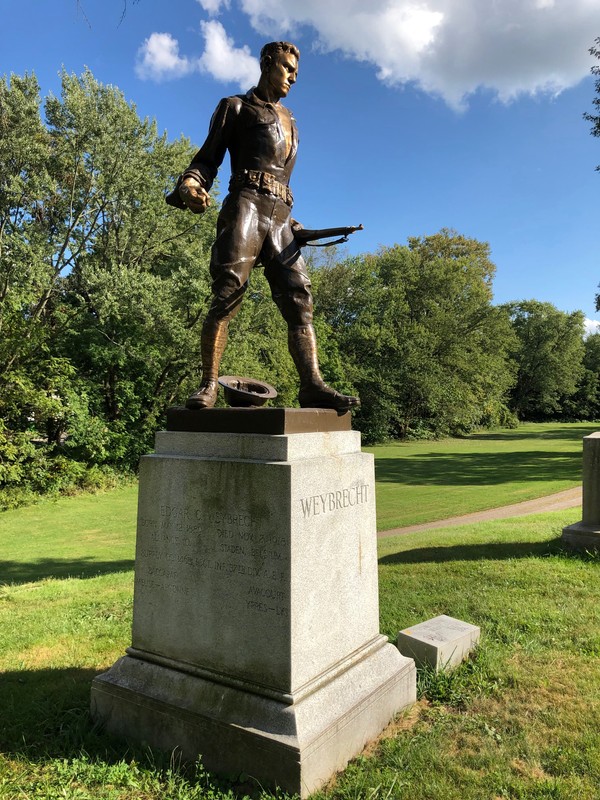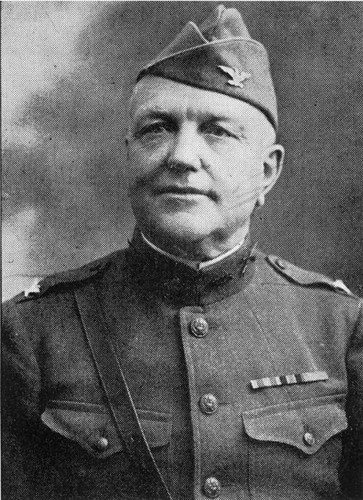Fighting Doughboy / Weybrecht Memorial
Introduction
Author-Uploaded Audio
Listen to a narration of this entry's description by Alliance Historical Society.
Text-to-speech Audio
Col. Charles C. Weybrecht, son of John T. Weybrecht, was a war hero who survived the Spanish-American War, the Mexican Border War chasing Pancho Villa, and World War I, but died three days after eating poisoned olives at his welcome home party held on August 23, 1919. He was one of seven persons who died from the botulism tainted olives. The Fighting Doughboy statue was created by Pietro Montana and was dedicated on November 11, 1922. The monument was purchased by Benjamin Weybrecht and stands as a remembrance to his brother Charles and his son Edgar C. Weybrecht, who died in Belgium in 1918, just nine days before the Armistice was signed.
Images
Fighting Doughboy by Pietro Montana

Col. Charles C. Weybrecht

Backstory and Context
Text-to-speech Audio
Perhaps the most famous of the monuments in Alliance City Cemetery, this World War I Doughboy serves as a memorial to one of Alliance’s most distinguished sons and his nephew.
Edgar Weybrecht, the son of Benjamin F. Weybrecht, joined the army in May 1918. He immediately went to France, where he served the 146th under his uncle Charles Weybrecht’s leadership. Unfortunately he died of pneumonia only 9 days before the Armistice was signed.
Col. Charles C. Weybrecht loved the military and rose through the ranks from Major in the Spanish American War to Colonel during World War I. He returned home in July 1919. A special dinner party was held in his honor on August 23, 1919, at which a jar of ripe Black olives was served. The olives were tainted with botulism and Weybrecht, as well as six others, died as a result of eating them.
In November 1921, Col. Weybrecht’s brother and Edgar’s father, B.F. Weybrecht, attended the unveiling of the Fighting Doughboy statue by Pietro Montana in Brooklyn, NY. He was so taken by the statue’s resemblance to his son, that he commissioned another casting to serve as a memorial to his fallen family members. Montana’s Fighting Doughboy was the winner of a 1919 war memorial competition and was his professional debut work. It depicts an aggressive soldier with clenched fist, his shirt opened, his helmet beneath him, and a rifle in his other hand.
The memorial was dedicated November 11, 1922. The City Band led a procession of Civil War, Spanish American War, and World War I veterans to the cemetery for the unveiling.
The Doughboy stood ready to fight for nearly 80 years when a violent thunderstorm broke a large branch from a neighboring tree. The heavy limbs landed atop the statue, pushing the head into the chest cavity, collapsing the chest. The arm was snapped off and the top part of the statue was broken off at the knees. The statue was painstakingly restored and returned to the cemetery in July 2001. It is impossible to see where the damage occurred.
In the words of Col. Frank Gerlach, who spoke at the 1922 dedication, “We dedicate this monument, not to the glorification of war, but rather as a memorial to humanity’s progress and worldwide struggle for universal peace.”
Sources
Marking Time in Alliance - Weybrecht Memorial. Perone, Karen. Performed by Jim Perone. Alliance Historical Society, 2020. https://www.youtube.com/watch?v=gJrIxyJugGE.
"Food Poison Death Toll Six." The Alliance Review (Alliance, Ohio) August 27th 1919. p.1.
"Unveil Marker Honoring Dead World War Vets." The Alliance Review (Alliance, Ohio) November 11th 1922. p.1, 5.
Photograph by Karen Perone
https://www.alliancememory.org/digital/collection/people/id/283/rec/9
